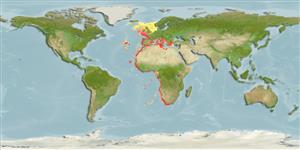Common names from other countries
Environment: milieu / climate zone / depth range / distribution range
Sinh thái học
; Mức độ sâu 10 - 1212 m (Ref. 435), usually 80 - 350 m (Ref. 435). Temperate; 64°N - 36°S, 34°W - 29°E
Eastern Atlantic and the Mediterranean: from Morocco to Angola and off lying islands, northwards to Hebrides and Southwest Norway, also in Mediterranean as far as Greece.
Length at first maturity / Bộ gần gũi / Khối lượng (Trọng lượng) / Age
Maturity: Lm 7.2 range ? - ? cm Max length : 21.5 cm CL con đực/không giới tính; (Ref. 435)
Maximum depth from Ref. 106053. In bathyal oceanic communities (Ref. 96584). Occurs at depths from 10 to 1000 m, common at depths of 80 to 350 m (Ref. 435). Deep-water species, recorded down to 1212 m. Found in the shelf (Ref. 105470), upper and middle slope (Ref. 96584). where it is abundant in the latter (Ref. 96584). Prefers intermixed bathyal mud and emerging rocky substrates. Reported to be among cold-water coral community, specifically on coral mounds and coral habitats on muddy bottoms (Ref. 96584). Also found on seamounts (Ref. 122979). Carries a sponge on its back with its fifth pereiopods. Predator of benthic decapods (Ref. 96584) and an active scavenger (Refs. 96584, 106053).
Members of the order Decapoda are mostly gonochoric. Mating behavior: Precopulatory courtship ritual is common (through olfactory and tactile cues); usually indirect sperm transfer.
Fischer, W., G. Bianchi and W.B. Scott (eds.). 1981. (Ref. 435)
IUCN Red List Status (Ref. 130435)
CITES status (Ref. 108899)
Not Evaluated
Not Evaluated
Human uses
Các nghề cá: Tính thương mại
| FishSource |
Các công cụ
Các nguồn internet
Estimates based on models
Preferred temperature
(Ref.
115969): 10 - 16.4, mean 13.3 (based on 388 cells).
Thích nghi nhanh
Chiêù cao, thời gian nhân đôi của chủng quần tối thiểu là dưới 15 tháng (Fec=217,000).
Vulnerability
Low vulnerability (12 of 100).
Price category
Unknown.
